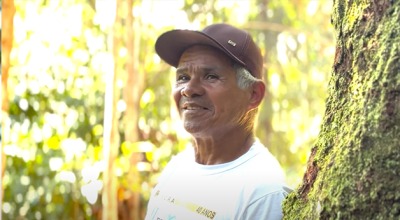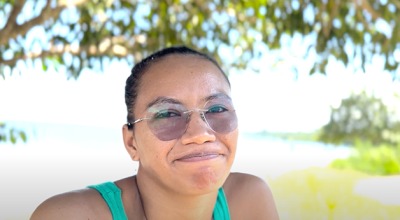Notes from the Field: Community Resilience in the Face of a Changing Amazon

As the largest rainforest on Earth, the Brazilian Amazon is infinitely important to biodiversity conservation, to our planet’s climate, and to the communities who live there and are sustained by its bounty. Working to protect as much as possible of this irreplaceable tropical biome before it is lost is a top priority for Rainforest Trust.
Early in July, two of our staff members, James Lewis, VP of Conservation, and Andrea Carneiro, Conservation Strategist for Latin America, traveled to the heart of the Brazilian Amazon to visit communities deeply involved in conservation efforts in the region. Their destination was Lake Tefé, where Rainforest Trust has supported our partner, Instituto Internacional de Educação do Brasil (IIEB), to safeguard 1,280,981 acres of primary rainforest within the buffer area of the 2.5-million-acre Tefé National Forest Protected Area adjacent to Lake Tefé.
After landing in Tefé, a well-developed town with a commercial airport, they traveled over 60 miles by boat to visit four communities living in the Tefé rainforest. Their trip was inspiring on many levels.
“Our recent trip to Tefé left a lasting impression,” Andrea reports. “James Lewis and I had the privilege of meeting with the eight Community Council leaders and I was deeply moved by the remarkable work they are doing to safeguard the Amazon forest while navigating the complex process of land tenure regularization, supported by Rainforest Trust grantee, IIEB.”
“It’s always great to hear from individuals,” James said. “So often we’re involved in high-level discussions about policy, legislation, how protected areas are established. Actually being able to meet in person and connect the people themselves and their personalities and experiences with the conservation that we’re helping achieve, it’s so meaningful for me. And I know it is meaningful for our donors to hear from local people as well.”
The Lake Tefé project is an excellent example of how Rainforest Trust supports partners working towards formal government recognition of the land tenure rights of Indigenous and traditional communities—a status that also grants them the power to manage and protect their lands, waters, and resources.
This protection is essential, as communities in the Amazon are facing unprecedented challenges and threats to their survival. James and Andrea heard from those they visited about the devastation caused by the extended drought of 2023 that hit the Amazon and nearly dried up Lake Tefé—a lake that measures 50 to 65 feet deep in its deepest spots. No one in the villages they visited had living memory of the lake ever drying up before.
“One of the most striking sights was the Tefé Lake, which was at its fullest during our visit,” said Andrea. “It was hard to imagine that just months earlier, this massive body of water had nearly dried up, causing immense destruction and despair for both nature and the people who depend on it. The resilience of the region is evident, but the memory of that crisis still lingers.”

(Left) A replenished Lake Tefé; (Right) Lake Tefé during the drought in fall 2023.
The famine that followed the drought reverberated across the Amazon. As fish died by the millions in Lake Tefé, the traditional fishing livelihoods of the people were lost for the season. Their only means of transportation—the rivers—became unnavigable, so they were completely cut off. The effects are still being felt, with dramatically lower fish stocks this year due to the devastating losses last year. This year, the dry season has started earlier than ever, fueling dire predictions of another drought for a region already reeling from major changes to the global climate. This is a trend that is being amplified across the entire Amazon basin each year as the effects of climate change are growing.
Heaped onto these setbacks, the ongoing destruction and degradation of the rainforest from logging, mining and the spread of agriculture, cattle ranching and other development marches forward. Though the rainforests here have been inhabited for generations by traditional communities of fishermen, Brazilian nut gatherers and rubber tappers, their lives and livelihoods are increasingly threatened by criminal activities due to the lack of clear land ownership rights. Lake Tefé communities are also impacted by unregulated tourism spreading from its shores, given the region’s astounding beauty.
To address the urgency of Amazon conservation, Rainforest Trust created the Brazilian Amazon Fund in 2023 to raise $40 million to permanently safeguard 20 million acres of intact forest—an expanse the size of South Carolina—as new protected areas and Indigenous territories. These projects will also safely lock up 6 billion metric tons of CO2 equivalents (more than the U.S.’s annual total CO2 emissions). Our collaborative project in the Amazon rainforest near Lake Tefé is one of the first projects of six to benefit so far from our donors’ generosity to this fund.
Donate to Save the Brazilian Amazon

Quilombola community members carrying water, walking through what usually is the bottom of Lake Tefé. Photo taken on Sept 07 2024. Photo courtesy of IIEB

James and Andrea pose for a photo by Lake Tefé in the Brazilian Amazon.

An old-growth tree from the Lake Tefé area of the Brazilian Amazon. Photo by James Lewis

A home on the shore of Lake Tefé. Photo by James Lewis

Children from a local community near Lake Tefé, play football.

Members of APAFE pushing a boat recently purchased with Rainforest Trust project funds. They travel along a stream left behind when Lake Tefé nearly disappeared during the drought. Photo taken on Sept 9 2024, courtesy of IIEB

Lake Tefé in 2023 during the drought

A replenished Lake Tefé in July 2024, near the end of the rainy season.
The Lake Tefé Community Speaks
Andrea and James spoke with a number of community members, and their insights are essential to understanding day-to-day life in the forests around Lake Tefé.
Marineide Leocádio da Silva

Marineide is a leader from the Tauari community, where she has lived for 28 years. The Tauari community is one of those seeking legal designation of their territories. Marineide is one of four community members working to establish ecotourism in the area. Although in its early stages, the program is already generating income for the community through sales of high-quality cassava, yams, Brazil nuts, and fish to visitors and to local markets in the Amazon. The plan is to build huts to safely house visitors for overnight stays.
“We want to improve our way of living without leaving our communities or the forest,” Marineide said. “My message to young people who wish to stay in the area is, take care of the forest, take care of the community, because it’s not just for us, it’s also for those who will come after us. This is what true quality of life means.”
Click to watch the full interview with Marineide
Celion Juscelino

Celion, an elderly community leader who is about 70 years old, is standing next to a Brazil-nut Tree that is well over 700 years old. He moved to this village near Tefé when he was nine years old and has lived here since. At that time, there was no community, no running water, electricity, or ice. Everything came from nature. One had to walk hours to reach a neighbor’s house. He is deeply connected to the natural environment around Lake Tefé.
“If you preserve nature, you’re preserving life,” Celion said with feeling. “That’s why I’m still around. If one day I come here and see this tree fallen, for me, it would be the end of the world. I consider it a mother to me. How many years has it not fed me, from when I was nine years old to the age I am today? It continues to produce, even with this big problem here. [Note: The tree has a large crack up its trunk.] It is the ‘mother of all trees’ because it is the oldest in the region and the mother to all the other Brazil-nut Trees around.”
To make his living, Celion gathers Brazil nuts, roasts them and makes products from them, and he also keeps bees.
Click to watch the full interview with Celion Juscelino
Elisabete Lopes Faustino

Elisabete is a science teacher in the schools and is pursuing her Master’s Degree at State University of Amazonas. She lives in the Quilombola community of São Francisco do Bauana. Quilombolas are remote Afro-Brazilian communities founded by people who escaped slavery; the earliest date back to the 1600s. Her community is currently fighting for its land rights.
“It’s a great joy to be able to leave my community to get an education and come back to contribute to my home,” Elisabete said. “I feel privileged to have been blessed with this grace. We are guardians of the forest, of the waters, every day, every hour. Our well-being depends on the health of our forests.”
Moving from Lake Tefé in the Amazon to the city for school, Elisabete noticed the differences. In her forest community, the people work collectively, exchanging food to support each other, joining together to help someone when they are sick. But she also remembers when the Amazon was opened up to industrial fishing during her parents’ generation, when ocean fishing fleets came up the Amazon and to Lake Tefé and just cleaned out the fish. She saw the degradation caused by industrial operations. Her generation wants to make sure that doesn’t happen again.
Click to watch the full interview with Elisabete
Shifting the Trajectory from Destruction to Protection
The history of the Amazon is a long one where outside interests descend and take what they want with no regard for Indigenous communities or lasting biodiversity. Now, climate change is taking its toll.
“It was encouraging to see that the communities are organizing and preparing for another potential drought,” Andrea said. “After the hardships of the past, they are determined not to be caught off guard again. Their resilience and foresight give hope for the future, but also make us reflect on the impacts of climate change. The unsustainable use of natural resources by humans disproportionately affects those living closest to nature, who often have the smallest carbon footprint. This is, at the very least, unfair.”
But we have the unprecedented opportunity to change the trajectory of destruction and degradation in the Brazilian Amazon.
Rainforest Trust and our partners and donors are developing new projects in the region as quickly as possible, with Andrea leading our project development efforts there. Now is the time to support this critical work through Rainforest Trust’s Brazilian Amazon Fund.
“These visits gave me a lot of hope that the communities, once empowered with land-tenure rights, will be able to build resilience to ensure the long-term protection of their territories,” James said.
This is indeed good news for all.
Join Our Fight to Save the Brazilian Amazon









